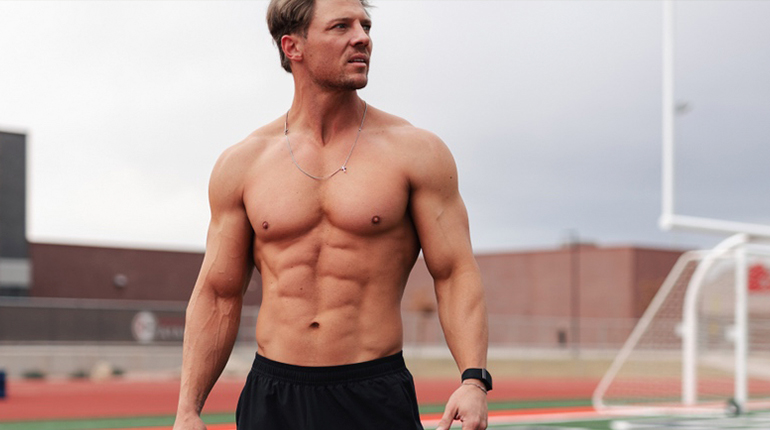
The pursuit of physical strength has captivated humanity for centuries. From ancient warriors to modern athletes, the ideal physique often conjures images of power, agility, and resilience. A 6ft 200 lbs man stands as a quintessential example, embodying a physique widely recognized as synonymous with athleticism and physical prowess. This article delves into the intricacies of an athletic physique, exploring its definition, ideal body composition for strength, benefits, and practical strategies for achieving this coveted build.
This comprehensive guide will navigate through the key aspects of developing an athletic physique, providing insights into the science behind muscle growth, optimal nutrition, and effective training regimens. By understanding these principles, individuals can embark on a journey to sculpt their bodies into powerful and functional machines.
Athletic Physique Definition
An athletic physique transcends mere aesthetics; it represents a harmonious blend of muscular development, lean body mass, and cardiovascular fitness. It’s characterized by well-defined muscle groups, low body fat percentage, and enhanced endurance capabilities.
The specific dimensions of an “ideal” athletic physique can vary depending on individual goals and sport disciplines. However, certain common traits emerge: a strong core, developed upper and lower body musculature, and proportionate limbs. This balanced composition allows for both strength and agility, enabling individuals to excel in various physical activities.
Key Components
- Muscular Development: Defined muscle groups contribute to overall strength and power output.
- Lean Body Mass: A high percentage of lean mass (muscle and bone) is crucial for metabolic efficiency and calorie expenditure.
- Low Body Fat Percentage: Maintaining a low body fat level enhances athletic performance, improves cardiovascular health, and promotes a sculpted appearance.
Ideal Body Composition for Strength
While individual variations exist, certain body composition ratios are generally associated with optimal strength potential. A healthy balance between muscle mass and body fat is essential.
For men aiming to maximize strength, a target body fat percentage of 10-15% is often recommended. This allows for sufficient muscle development while maintaining functional mobility and performance. Conversely, excessively low body fat percentages can hinder hormone production and negatively impact overall health.
Factors Influencing Body Composition
- Genetics: Individual genetic predispositions influence muscle fiber type distribution and body fat storage patterns.
- Training Intensity and Volume: Progressive overload through resistance training stimulates muscle growth and hypertrophy.
- Nutrition: Adequate protein intake is crucial for muscle repair and synthesis, while calorie control influences body fat levels.
Benefits of an Athletic Build
Cultivating an athletic physique extends beyond aesthetics; it offers a multitude of physical, mental, and social benefits.
Physical Advantages: Increased strength, power, endurance, improved bone density, enhanced metabolism, reduced risk of chronic diseases. Mental Benefits: Boosted self-confidence, increased resilience, reduced stress levels, improved body image. Social Advantages: Enhanced athletic performance, greater participation in physical activities, increased social interaction and opportunities.
Achieving an Athletic Physique
Transforming your physique into a powerful and functional machine requires a multifaceted approach encompassing both training and nutrition.
Training: Focus on compound exercises that engage multiple muscle groups simultaneously, such as squats, deadlifts, bench presses, and overhead presses. Incorporate progressive overload by gradually increasing weight, reps, or sets over time. Nutrition: Prioritize whole, unprocessed foods, including lean protein sources, complex carbohydrates, healthy fats, fruits, and vegetables. Ensure adequate calorie intake to support muscle growth while maintaining a slight caloric deficit for fat loss.
Training Strategies
- Resistance Training: Lift weights progressively to stimulate muscle hypertrophy and strength gains.
- Cardiovascular Exercise: Engage in activities like running, swimming, or cycling to improve cardiovascular health and endurance.
- Flexibility and Mobility Work: Incorporate stretching and mobility exercises to enhance range of motion and prevent injuries.
Nutritional Guidelines
- Protein Intake: Aim for 1.6-2.2 grams of protein per kilogram of body weight daily to support muscle repair and growth.
- Carbohydrate Consumption: Choose complex carbohydrates like whole grains, fruits, and vegetables for sustained energy levels.
- Healthy Fats: Include sources like avocados, nuts, seeds, and olive oil for hormone production and overall health.
Conclusion
The pursuit of an athletic physique is a journey that demands dedication, discipline, and a holistic approach encompassing both training and nutrition. By understanding the principles outlined in this article, individuals can embark on a transformative path to sculpt their bodies into powerful and functional machines. Remember, consistency is key; gradual progress over time yields lasting results. Embrace the challenge, push your limits, and unlock your full athletic potential.
